Evaluating the Effects of Long-Term Salinity Stress on the Growth and Physiology of Mono and Mixed Crops
Abstract
:1. Introduction
2. Materials and Methods
2.1. Plant Materials and Experimental Design
2.2. Measurement of Leaf Area and Biomass
2.3. Measurements of SPAD, Photosynthesis Rate
2.4. Crude Protein, ADF, and NDF in Plant Tissues
2.5. Statistical Analysis
3. Results
3.1. Growth and Biomass
3.2. SPAD, Specific Leaf Area (SLA), and Photosynthesis
3.3. Elemental Analysis and Crop Quality
4. Discussion
5. Conclusions
Supplementary Materials
Author Contributions
Funding
Data Availability Statement
Conflicts of Interest
References
- FAO World Livestock: Transforming the Livestock Sector through the Sustainable Development Goals; FAO: Rome, Italy, 2018.
- Duan, C.; Shi, P.; Zong, N.; Wang, J.; Song, M.; Zhang, X. Feeding Solution: Crop-Livestock Integration via Crop-Forage Rotation in the Southern Tibetan Plateau. Agric. Ecosyst. Environ. 2019, 284, 106589. [Google Scholar] [CrossRef]
- Yang, Y.; Zhang, H.; Liu, W.; Sun, J.; Zhao, M.; Han, G.; Pan, Q. Effects of Grazing Intensity on Diversity and Composition of Rhizosphere and Non-Rhizosphere Microbial Communities in a Desert Grassland. Ecol. Evol. 2023, 13, e10300. [Google Scholar] [CrossRef]
- Lee, J.M.; Clark, D.A.; Clark, C.E.F.; Waugh, C.D.; Roach, C.G.; Minneé, E.M.K.; Glassey, C.B.; Woodward, S.L.; Woodfield, D.R.; Chapman, D.F. A Comparison of Perennial Ryegrass- and Tall Fescue-Based Swards with or without a Cropping Component for Dairy Production: Animal Production, Herbage Characteristics and Financial Performance from a 3-Year Farmlet Trial. Grass Forage Sci. 2018, 73, 340–354. [Google Scholar] [CrossRef]
- Bengtsson, J.; Bullock, J.M.; Egoh, B.; Everson, C.; Everson, T.; O’Connor, T.; O’Farrell, P.J.; Smith, H.G.; Lindborg, R. Grasslands—More Important for Ecosystem Services than You Might Think. Ecosphere 2019, 10, e02582. [Google Scholar] [CrossRef]
- Atta, K.; Mondal, S.; Gorai, S.; Singh, A.P.; Kumari, A.; Ghosh, T.; Roy, A.; Hembram, S.; Gaikwad, D.J.; Mondal, S.; et al. Impacts of Salinity Stress on Crop Plants: Improving Salt Tolerance through Genetic and Molecular Dissection. Front. Plant Sci. 2023, 14, 1241736. [Google Scholar] [CrossRef]
- Acosta-Motos, J.R.; Ortuño, M.F.; Bernal-Vicente, A.; Diaz-Vivancos, P.; Sanchez-Blanco, M.J.; Hernandez, J.A. Plant Responses to Salt Stress: Adaptive Mechanisms. Agronomy 2017, 7, 18. [Google Scholar] [CrossRef]
- Junedi, M.A.; Mukhopadhyay, R.; Manjari, K.S. Alleviating Salinity Stress in Crop Plants Using New Engineered Nanoparticles (ENPs). Plant Stress 2023, 9, 100184. [Google Scholar] [CrossRef]
- Arshad, M.; Gruber, M.Y.; Wall, K.; Hannoufa, A. An Insight into MicroRNA156 Role in Salinity Stress Responses of Alfalfa. Front. Plant Sci. 2017, 8, 356. [Google Scholar] [CrossRef] [PubMed]
- Qiu, Y.; Wang, Y.; Fan, Y.; Hao, X.; Li, S.; Kang, S. Root, Yield, and Quality of Alfalfa Affected by Soil Salinity in Northwest China. Agriculture 2023, 13, 750. [Google Scholar] [CrossRef]
- Chakrabarti, M.; Nagabhyru, P.; Schardl, C.L.; Dinkins, R.D. Differential Gene Expression in Tall Fescue Tissues in Response to Water Deficit. Plant Genome 2022, 15, e20199. [Google Scholar] [CrossRef] [PubMed]
- Fan, S.; Amombo, E.; Yin, Y.; Wang, G.; Avoga, S.; Wu, N.; Li, Y. Root System Architecture and Genomic Plasticity to Salinity Provide Insights into Salt-Tolerant Traits in Tall Fescue. Ecotoxicol. Environ. Saf. 2023, 262, 115315. [Google Scholar] [CrossRef] [PubMed]
- Ergon, Å.; Bakken, A.K. Breeding for Intercropping: The Case of Red Clover Persistence in Grasslands. Euphytica 2022, 218, 98. [Google Scholar] [CrossRef]
- Sharavdorj, K.; Byambadorj, S.O.; Jang, Y.; Cho, J.W. Application of Magnesium and Calcium Sulfate on Growth and Physiology of Forage Crops under Long-Term Salinity Stress. Plants 2022, 11, 3576. [Google Scholar] [CrossRef] [PubMed]
- Hou, C.; Li, X.; Tian, D.; Xu, B.; Zhang, C.; Ren, J.; Chen, N. Evaluation of the Effects of Water and Salinity Stress on the Growth and Biochemistry of Alfalfa (Medicago sativa L.) at the Branching Stage. Sustainability 2022, 14, 10262. [Google Scholar] [CrossRef]
- Kumar, S.; Li, G.; Yang, J.; Huang, X.; Ji, Q.; Liu, Z.; Ke, W.; Hou, H. Effect of Salt Stress on Growth, Physiological Parameters, and Ionic Concentration of Water Dropwort (Oenanthe javanica) Cultivars. Front. Plant Sci. 2021, 12, 660409. [Google Scholar] [CrossRef] [PubMed]
- Fernandez, A.L.; Fabrizzi, K.P.; Tautges, N.E.; Lamb, J.A.; Sheaffer, C.C. Cutting Management and Alfalfa Stand Age Effects on Organically Grown Corn Grain Yield and Soil N Availability. Renew. Agric. Food Syst. 2019, 34, 144–154. [Google Scholar] [CrossRef]
- Hosseini-Nasr, F.; Etesami, H.; Alikhani, H.A. Silicon Improves Plant Growth-Promoting Effect of Nodule Non-Rhizobial Bacterium on Nitrogen Concentration of Alfalfa Under Salinity Stress. J. Soil Sci. Plant Nutr. 2023, 23, 496–513. [Google Scholar] [CrossRef]
- Ondrasek, G.; Rathod, S.; Manohara, K.K.; Gireesh, C.; Anantha, M.S.; Sakhare, A.S.; Parmar, B.; Yadav, B.K.; Bandumula, N.; Raihan, F.; et al. Salt Stress in Plants and Mitigation Approaches. Plants 2022, 11, 717. [Google Scholar] [CrossRef]
- Sharavdorj, K.; Jang, Y.; Byambadorj, S.O.; Cho, J.W. The Effect of MgSO4 and CaSO4 on Seedlings of Forage Crops under Environmental Stress. Plant Physiol. Rep. 2022, 27, 702–716. [Google Scholar] [CrossRef]
- Chamkhi, I.; Cheto, S.; Geistlinger, J.; Zeroual, Y.; Kouisni, L.; Bargaz, A.; Ghoulam, C. Legume-Based Intercropping Systems Promote Beneficial Rhizobacterial Community and Crop Yield under Stressing Conditions. Ind. Crops Prod. 2022, 183, 114958. [Google Scholar] [CrossRef]
- Dai, J.; Qiu, W.; Wang, N.; Wang, T.; Nakanishi, H.; Zuo, Y. From Leguminosae/Gramineae Intercropping Systems to See Benefits of Intercropping on Iron Nutrition. Front. Plant. Sci. 2019, 10, 605. [Google Scholar] [CrossRef]
- Gizachew Raji, S.; Dörsch, P. Effect of Legume Intercropping on N2O Emissions and CH4 Uptake during Maize Production in the Great Rift Valley, Ethiopia. Biogeosciences 2020, 17, 345–359. [Google Scholar] [CrossRef]
- Massawe, P.I.; Mtei, K.M.; Munishi, L.K.; Ndakidemi, P.A. Improving Soil Fertility and Crops Yield through Maize-Legumes (Common Bean and Dolichos Lablab) Intercropping Systems. J. Agric. Sci. 2016, 8, 148. [Google Scholar] [CrossRef]
- Tuna, A.L.; Kaya, C.; Ashraf, M.; Altunlu, H.; Yokas, I.; Yagmur, B. The Effects of Calcium Sulphate on Growth, Membrane Stability and Nutrient Uptake of Tomato Plants Grown under Salt Stress. Environ. Exp. Bot. 2007, 59, 173–178. [Google Scholar] [CrossRef]
- Garnier, E.; Shipley, B.; Roumet, C.; Laurent, G. A Standardized Protocol for the Determination of Specific Leaf Area and Leaf Dry Matter Content. Funct. Ecol. 2001, 15, 688–695. [Google Scholar] [CrossRef]
- Pereira, S.; Singh, S.; Oliveira, R.S.; Ferreira, L.; Rosa, E.; Marques, G. Co-Inoculation with Rhizobia and Mycorrhizal Fungi Increases Yield and Crude Protein Content of Cowpea (Vigna unguiculata (L.) Walp.) under Drought Stress. Landbauforschung 2020, 70, 56–65. [Google Scholar] [CrossRef]
- Van Soest, P.J.; Robertson, J.B.; Lewis, B.A. Methods for Dietary Fiber, Neutral Detergent Fiber, and Nonstarch Polysaccharides in Relation to Animal Nutrition. J. Dairy Sci. 1991, 74, 3583–3597. [Google Scholar] [CrossRef]
- SAS Institute Inc. SAS Software; 9.4; SAS Institute Inc.: Cary, NC, USA, 2014; pp. 1–25. [Google Scholar]
- R Core Team. R: A Language and Environment for Statistical Computing; R Core Team: Vienna, Austria, 2021. [Google Scholar]
- Ahmad, I.; Zhu, G.; Zhou, G.; Younas, M.U.; Suliman, M.S.E.; Liu, J.; Zhu, Y.; Salih, E.G.I. Integrated Approaches for Increasing Plant Yield under Salt Stress. Front. Plant Sci. 2023, 14, 1215343. [Google Scholar] [CrossRef]
- Verma, T.; Bhardwaj, S.; Singh, J.; Kapoor, D.; Prasad, R. Triacontanol as a Versatile Plant Growth Regulator in Overcoming Negative Effects of Salt Stress. J. Agric. Food Res. 2022, 10, 100351. [Google Scholar] [CrossRef]
- Hassan, M.U.; Kareem, H.A.; Hussain, S.; Guo, Z.; Niu, J.; Roy, M.; Saleem, S.; Wang, Q. Enhanced Salinity Tolerance in Alfalfa through Foliar Nano-Zinc Oxide Application: Mechanistic Insights and Potential Agricultural Applications. Rhizosphere 2023, 28, 100792. [Google Scholar] [CrossRef]
- Buscaglia, H.J.; Van Es, H.M.; Geohring, L.D.; Vermeulen, H.C.A.M.; Fick, G.W.; Lucey, R.E. Agroclimatology Alfalfa Yield and Quality Are Affected by Soil Hydrologic Conditions. Agron. J. 1994, 86, 535–542. [Google Scholar] [CrossRef]
- Ghaffarian, M.R.; Yadavi, A.; Movahhedi Dehnavi, M.; Dabbagh Mohammadi Nassab, A.; Salehi, M. Improvement of Physiological Indices and Biological Yield by Intercropping of Kochia (Kochia scoparia), Sesbania (Sesbania aculeata) and Guar (Cyamopsis tetragonoliba) under the Salinity Stress of Irrigation Water. Physiol. Mol. Biol. Plants 2020, 26, 1319–1330. [Google Scholar] [CrossRef]
- Panta, S.; Flowers, T.; Doyle, R.; Lane, P.; Haros, G.; Shabala, S. Temporal Changes in Soil Properties and Physiological Characteristics of Atriplex Species and Medicago Arborea Grown in Different Soil Types under Saline Irrigation. Plant Soil 2018, 432, 315–331. [Google Scholar] [CrossRef]
- Tang, L.; Zhou, Q.S.; Gao, Y.; Li, P. Biomass Allocation in Response to Salinity and Competition in Native and Invasive Species. Ecosphere 2022, 13, e3900. [Google Scholar] [CrossRef]
- Hedayati-Firoozabadi, A.; Kazemeini, S.A.; Pirasteh-Anosheh, H.; Ghadiri, H.; Pessarakli, M. Forage Yield and Quality as Affected by Salt Stress in Different Ratios of Sorghum Bicolor-Bassia Indica Intercropping. J. Plant Nutr. 2020, 43, 2579–2589. [Google Scholar] [CrossRef]
- Wang, S.; Zhao, Z.; Ge, S.; Zhang, K.; Tian, C.; Mai, W. The Effects of Suaeda Salsa/Zea mays L. Intercropping on Plant Growth and Soil Chemical Characteristics in Saline Soil. Agriculture 2022, 12, 107. [Google Scholar] [CrossRef]
- Rubinigg, M.; Wenisch, J.; Elzenga, J.T.M.; Stulen, I. NaCl Salinity Affects Lateral Root Development in Plantago Maritima. Funct. Plant Biol. 2004, 31, 775–780. [Google Scholar] [CrossRef] [PubMed]
- Arif, M.R.; Islam, M.T.; Robin, A.H.K. Salinity Stress Alters Root Morphology and Root Hair Traits in Brassica napus. Plants 2019, 8, 192. [Google Scholar] [CrossRef]
- Shalhevet, J.; Huck, M.G.; Schroeder, B.P.; Huck, G.; Schroeder, B. Root and Shoot Growth Responses to Salinity in Maize and Soybean. Agron. J. 1995, 87, 512–516. [Google Scholar] [CrossRef]
- Yang, Z.; Li, J.L.; Liu, L.N.; Xie, Q.; Sui, N. Photosynthetic Regulation Under Salt Stress and Salt-Tolerance Mechanism of Sweet Sorghum. Front. Plant Sci 2020, 10, 1722. [Google Scholar] [CrossRef]
- Hnilickova, H.; Kraus, K.; Vachova, P.; Hnilicka, F. Salinity Stress Affects Photosynthesis, Malondialdehyde Formation, and Proline Content in Portulaca oleracea L. Plants 2021, 10, 845. [Google Scholar] [CrossRef]
- Ferrari, F.N.; Parera, C.A. Germination of Six Native Perennial Grasses That Can Be Used as Potential Soil Cover Crops in Drip-Irrigated Vineyards in Semiarid Environs of Argentina. J. Arid. Environ. 2015, 113, 1–5. [Google Scholar] [CrossRef]
- Lu, Q.; Ge, G.T.; Sa, D.W.; Wang, Z.J.; Hou, M.L.; Jia, Y.S. Effects of Salt Stress Levels on Nutritional Quality and Microorganisms of Alfalfa-Influenced Soil. PeerJ 2021, 9, e11729. [Google Scholar] [CrossRef] [PubMed]
- Stoltz, E.; Nadeau, E. Effects of Intercropping on Yield, Weed Incidence, Forage Quality and Soil Residual N in Organically Grown Forage Maize (Zea mays L.) and Faba Bean (Vicia faba L.). Field Crops Res. 2014, 169, 21–29. [Google Scholar] [CrossRef]
- Law, E.P.; Wayman, S.; Pelzer, C.J.; DiTommaso, A.; Ryan, M.R. Intercropping Red Clover with Intermediate Wheatgrass Suppresses Weeds without Reducing Grain Yield. Agron. J. 2022, 114, 700–716. [Google Scholar] [CrossRef]
- Poustini, K.; Esmaeili, A.; Abbasi, A.; Sadeghpour, A. Ion Concentration and Energy Response of Two Wheat Cultivars to Salt Stress. J. Plant Nutr. 2020, 43, 1447–1457. [Google Scholar] [CrossRef]
- Manishankar, P.; Wang, N.; Köster, P.; Alatar, A.A.; Kudla, J. Calcium Signaling during Salt Stress and in the Regulation of Ion Homeostasis. J. Exp. Bot. 2018, 69, 4215–4226. [Google Scholar] [CrossRef] [PubMed]
- Knight, H.; Trewavas, A.J.; Knight, M.R. Calcium Signalling in Arabidopsis Thaliana Responding to Drought and Salinity. Plant J. 1997, 12, 1067–1078. [Google Scholar] [CrossRef]
- Su, R.; Zhang, Z.; Chang, C.; Peng, Q.; Cheng, X.; Pang, J.; He, H.; Lambers, H. Interactive Effects of Phosphorus Fertilization and Salinity on Plant Growth, Phosphorus and Sodium Status, and Tartrate Exudation by Roots of Two Alfalfa Cultivars. Ann. Bot. 2022, 129, 53–64. [Google Scholar] [CrossRef]
- Xu, H.X.; Weng, X.Y.; Yang, Y. Effect of Phosphorus Deficiency on the Photosynthetic Characteristics of Rice Plants. Russ. J. Plant Physiol. 2007, 54, 741–748. [Google Scholar] [CrossRef]

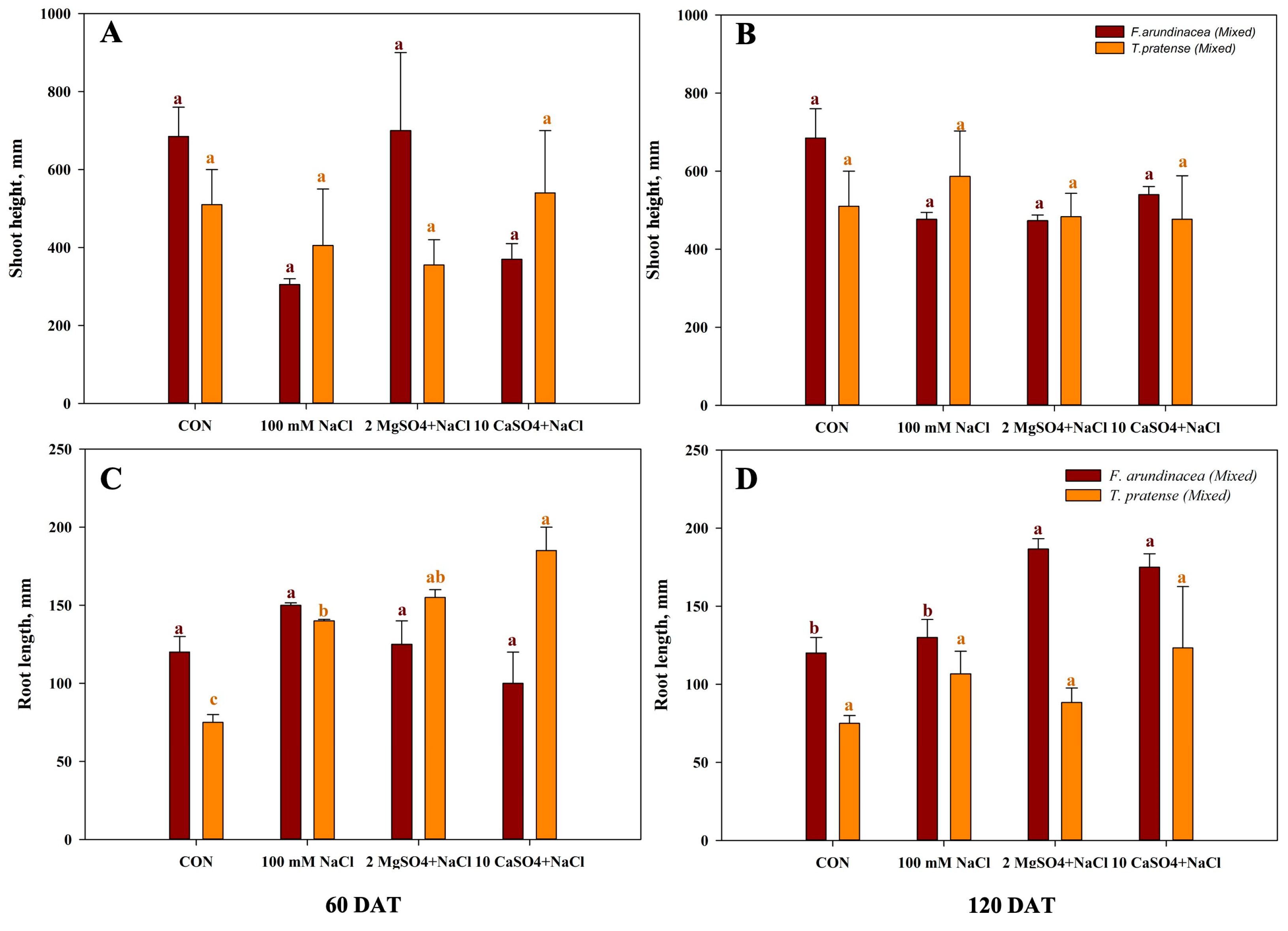

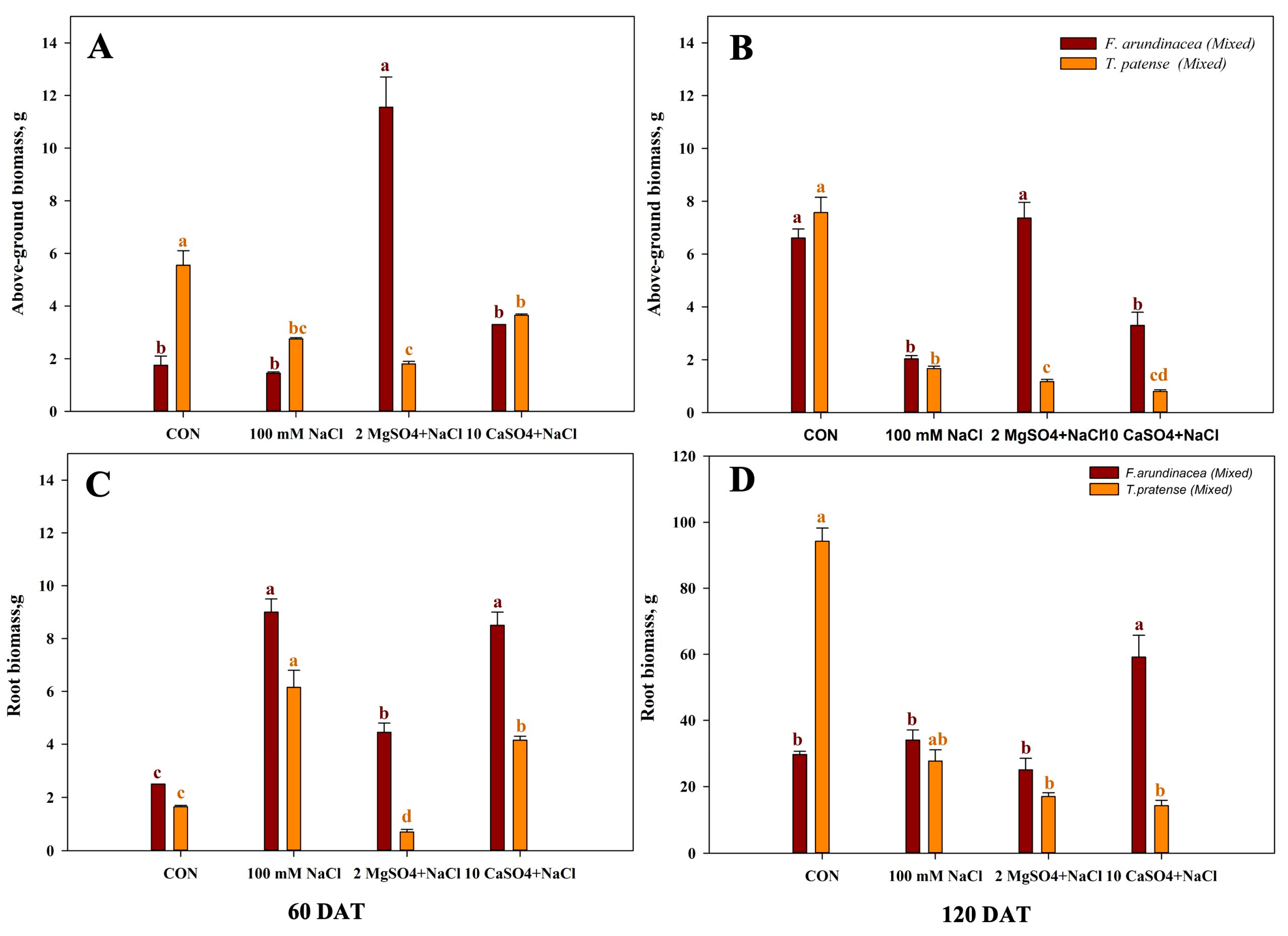
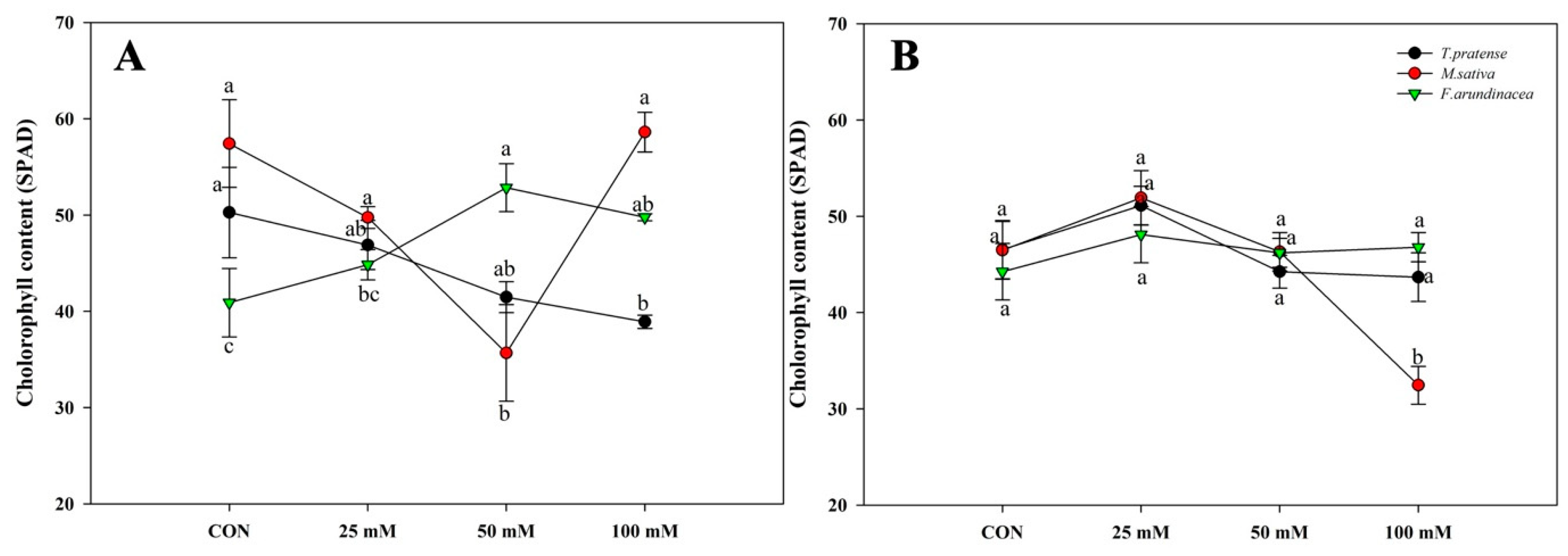

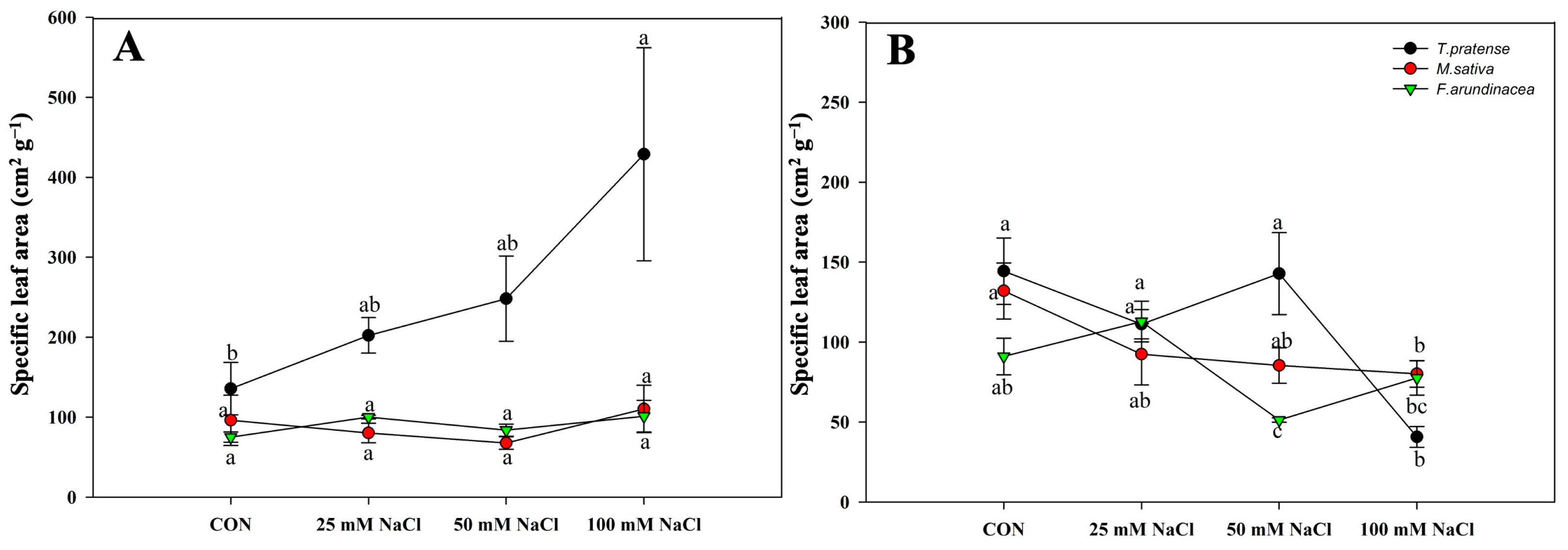


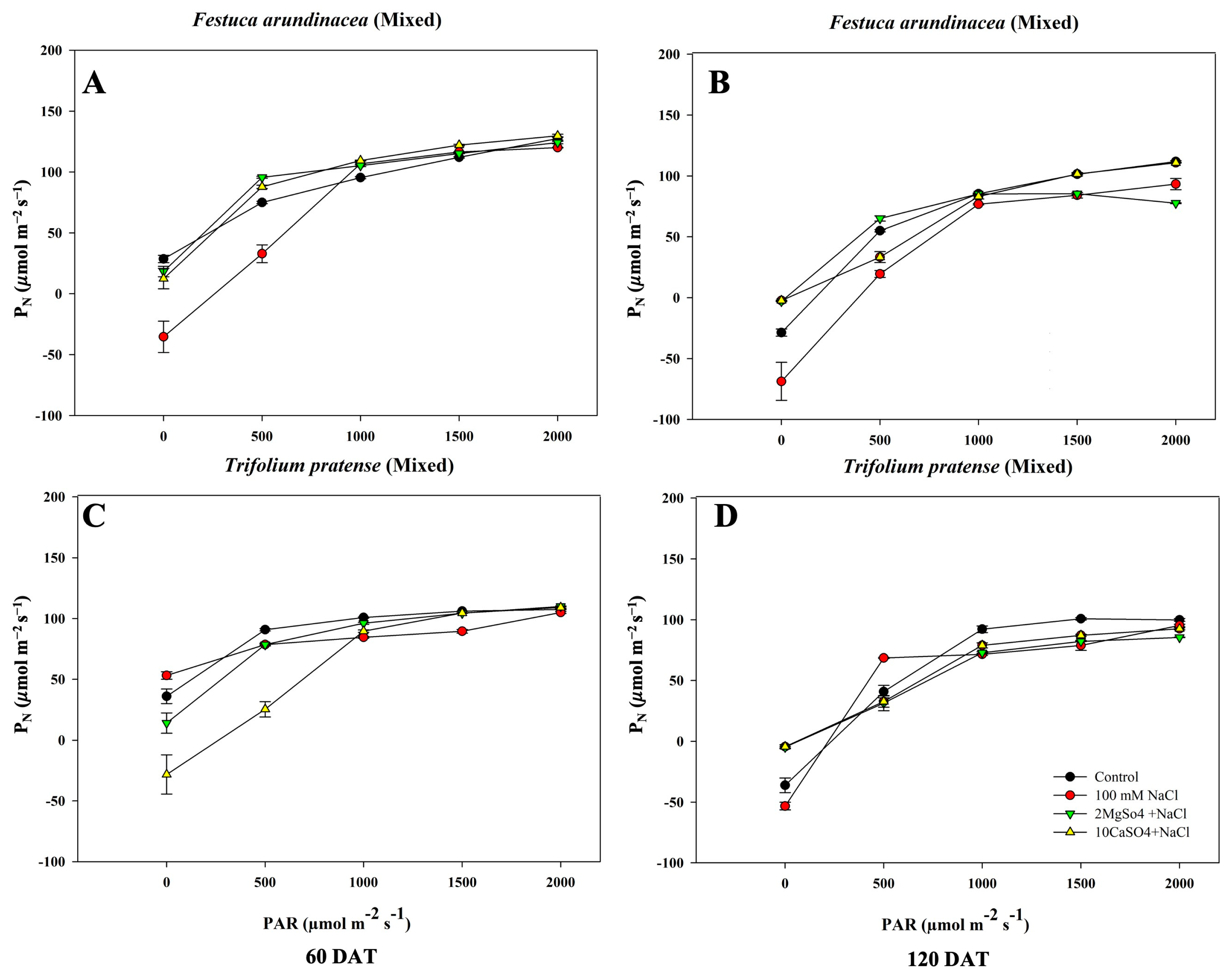
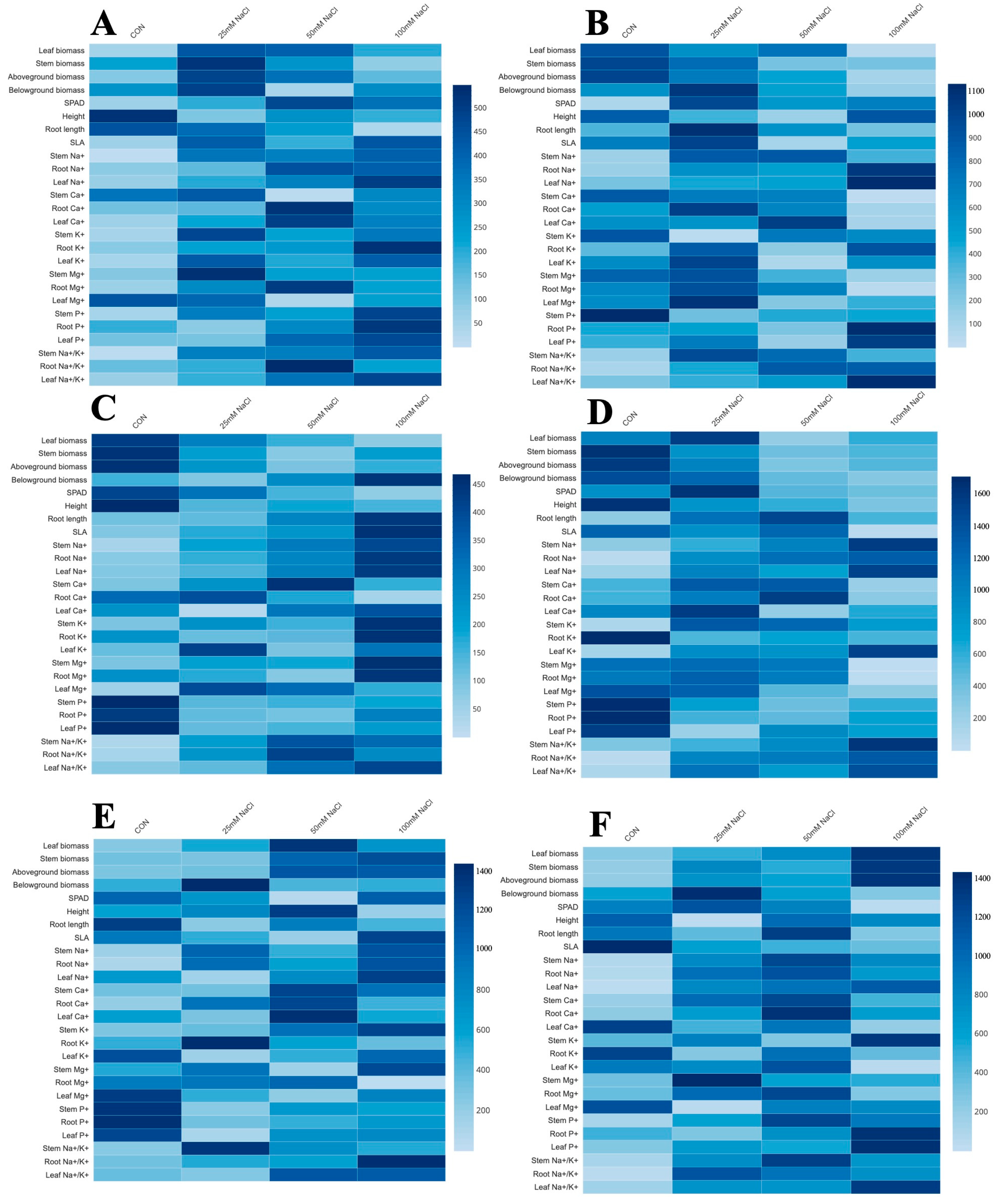
| Measurements | Species | Treatments | Measurements Period | Species × Measurements Period | Species × Treatments | Measurements Period × Treatments | ||||||||||||
|---|---|---|---|---|---|---|---|---|---|---|---|---|---|---|---|---|---|---|
| D | F | P | D | F | P | D | F | P | D | F | P | D | F | P | D | F | P | |
| Shoot height | 2 | 4.06 | 0.0214 | 3 | 3.22 | 0.0276 | 1 | 4.42 | 0.0391 | 2 | 1.72 | 0.1859 | 6 | 1.46 | 0.2040 | 3 | 0.77 | 0.5142 |
| Root length | 2 | 1.31 | 0.2766 | 3 | 1.43 | 0.2404 | 1 | 0.49 | 0.4852 | 2 | 0.84 | 0.4363 | 6 | 2.17 | 0.0557 | 3 | 1.89 | 0.1386 |
| Above-ground biomass | 2 | 297.71 | <0.0001 | 3 | 40.54 | <0.0001 | 1 | 556.52 | <0.0001 | 2 | 29.32 | <0.0001 | 6 | 68.21 | <0.0001 | 3 | 12.94 | <0.0001 |
| Root biomass | 2 | 633.27 | <0.0001 | 3 | 160.24 | <0.0001 | 1 | 2277.77 | <0.0001 | 2 | 583.28 | <0.0001 | 6 | 78.51 | <0.0001 | 3 | 153.21 | <0.0001 |
| Total Biomass | 2 | 496.39 | <0.0001 | 3 | 157.58 | <0.0001 | 1 | 2609.73 | <0.0001 | 2 | 402.00 | <0.0001 | 6 | 84.55 | <0.0001 | 3 | 141.91 | <0.0001 |
| SLA | 2 | 19.96 | <0.0001 | 3 | 0.89 | 0.4489 | 1 | 11.81 | 0.0010 | 2 | 12.47 | <0.0001 | 6 | 1.59 | 0.1635 | 3 | 6.72 | 0.0005 |
| SPAD | 2 | 1.08 | 0.3450 | 3 | 3.53 | 0.0190 | 1 | 2.15 | 0.1473 | 2 | 4.66 | 0.0124 | 6 | 5.14 | 0.0002 | 3 | 5.91 | 0.0012 |
| Measurement Period | Species | Treatments | ||||||
|---|---|---|---|---|---|---|---|---|
| CON | 25 mM NaCl | 50 mM NaCl | 100 mM NaCl | 2MS + NaCl | 10CS + NaCl | |||
| 60 DAT | T. pratense | CP | 15.011 b | 12.93 c | 17.39 a | 18.31 a | - | - |
| NDF | 31.95 a | 30.42 a | 25.74 a | 30.65 a | - | - | ||
| ADF | 29.47 a | 23.35 c | 21.59 d | 25.02 b | - | - | ||
| M. sativa | CP | 19.74 ab | 15.37 c | 18.01 b | 19.98 a | - | - | |
| NDF | 26 c | 34.01 a | 31.01 b | 24.28 c | - | - | ||
| ADF | 20.62 c | 26.75 a | 24.84 b | 20.61 c | - | - | ||
| F. arundinacea | CP | 13.15 b | 13.86 b | 18.42 a | 19.91 a | - | - | |
| NDF | 61.86 a | 61.20 a | 53.27 b | 48.59 c | - | - | ||
| ADF | 32.05 b | 33.92 a | 24.63 c | 25.71 c | - | - | ||
| Mixed cropping | CP | 16 a | - | - | 12.57 b | 13.40 b | 16.62 a | |
| NDF | 41.48 b | - | - | 41.76 b | 48.15 a | 47.51 a | ||
| ADF | 27.52 a | - | - | 28.27 a | 28.29 a | 27.43 a | ||
| 120 DAT | T. pratense | CP | 16.63 bc | 17.6 ab | 15.78 c | 18.49 a | - | - |
| NDF | 40.11 b | 33.69 c | 39.53 b | 42.27 a | - | - | ||
| ADF | 26.48 ab | 23.29 c | 25.55 b | 27.47 a | - | - | ||
| M. sativa | CP | 20.06 a | 20.23 a | 21.07 b | 18.00 ab | - | - | |
| NDF | 38.44 c | 34.5 bc | 35.26 ab | 43.29 a | - | - | ||
| ADF | 29.0 ab | 24.55 b | 24.60 a | 29.68 b | - | - | ||
| F. arundinacea | CP | 14.76 a | 15.43 a | 12.65 a | 14.43 b | - | - | |
| NDF | 57.57 b | 58.52 c | 60.30 c | 61.24 a | - | - | ||
| ADF | 28.06 a | 26.10 b | 29.43 b | 27.39 a | - | - | ||
| Mixed cropping | CP | 16.64 a | - | - | 15.46 ab | 14.27 c | 13.62 bc | |
| NDF | 53.63 c | - | - | 61.56 a | 59.95 b | 57.50 a | ||
| ADF | 29.85 a | - | - | 29.32 a | 29.12 a | 28.09 a | ||
Disclaimer/Publisher’s Note: The statements, opinions and data contained in all publications are solely those of the individual author(s) and contributor(s) and not of MDPI and/or the editor(s). MDPI and/or the editor(s) disclaim responsibility for any injury to people or property resulting from any ideas, methods, instructions or products referred to in the content. |
© 2024 by the authors. Licensee MDPI, Basel, Switzerland. This article is an open access article distributed under the terms and conditions of the Creative Commons Attribution (CC BY) license (https://creativecommons.org/licenses/by/4.0/).
Share and Cite
Sharavdorj, K.; Byambadorj, S.-O.; Jang, Y.; Ahn, Y.; Cho, J.-W. Evaluating the Effects of Long-Term Salinity Stress on the Growth and Physiology of Mono and Mixed Crops. Agronomy 2024, 14, 287. https://doi.org/10.3390/agronomy14020287
Sharavdorj K, Byambadorj S-O, Jang Y, Ahn Y, Cho J-W. Evaluating the Effects of Long-Term Salinity Stress on the Growth and Physiology of Mono and Mixed Crops. Agronomy. 2024; 14(2):287. https://doi.org/10.3390/agronomy14020287
Chicago/Turabian StyleSharavdorj, Khulan, Ser-Oddamba Byambadorj, Yeongmi Jang, Youngjik Ahn, and Jin-Woong Cho. 2024. "Evaluating the Effects of Long-Term Salinity Stress on the Growth and Physiology of Mono and Mixed Crops" Agronomy 14, no. 2: 287. https://doi.org/10.3390/agronomy14020287








